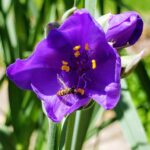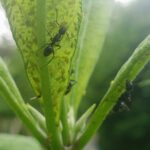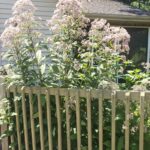Integrated Pest Management (IPM) is a proactive strategy that focuses on long-term prevention of pests by understanding the pest’s biology and utilizing a combination of control techniques. There are IPM strategies for all types of pests including weeds, insects, and diseases. Regardless of type, scouting and identification are the first and most critical steps in IPM.
With the large variety of plants possible in a landscape, IPM becomes more complex than in a conventional agricultural field, but it’s not futile and scouting a garden in bloom can be more interesting than a corn field. A diverse, pollinator-friendly garden in Indiana could easily host hundreds of insects. As a gardener or landscape professional, you should take a moment to watch what visits the flowers on occasion. Observe all the different insects, not just the pests, and you may find that it is too soon for chemical control.
While scouting in late June, numerous syrphid flies were found on the flowers of Ohio Spiderwort (Tradescantia ohiensis) (Figure 1). Syrphid flies, or hover flies, are often mistaken for a small bee and can be found hovering around flowers. Initially, they may seem like a pest but these harmless and beneficial insects actually feed on soft bodied pests like mealy bugs and aphids1.
- Figure 1. Syrphid fly on Ohio Spiderwort (Credit: K. Mitchell)
- Figure 2. Ants harvesting aphid honeydew, a sugar-rich sticky liquid, on underside of Joe Pye Weed leaf (Credit: K. Mitchell)
- Figure 3. Mature Joe Pye Weed in bloom (Credit: K. Mitchell)
Not far away, a line of ants climbing the stem of a Joe Pye Weed (Eupatorium maculatum) led to a colony of aphids (Figure 2). This symbiotic relationship between the ants and aphids is not beneficial to me or the plant. However, considering my high tolerance for insect damage, the vigor of Joe Pye Weed, and the thriving syrphid fly population nearby, intervention did not seem necessary. Instead, I monitored the pest population. Over the next two weeks, the aphid population dwindled to zero and the Joe Pye Weed is now over 6’ tall (Figure 3) and the flowering privacy screen remains.
By delaying, and ultimately avoiding the use of chemicals, the balance in the small garden ecosystem was restored without any human intervention. In a landscape seemingly full of pests, identify the good guys and let them do the dirty work for you. No PPE required.
More information on protecting pollinators and other beneficial insects can be found:
https://extension.entm.purdue.edu/publications/pubs/PollinatorProtection.html
References:
- University of California IPM program, Natural Enemies Gallery: https://www2.ipm.ucanr.edu/natural-enemies/syrphids/


